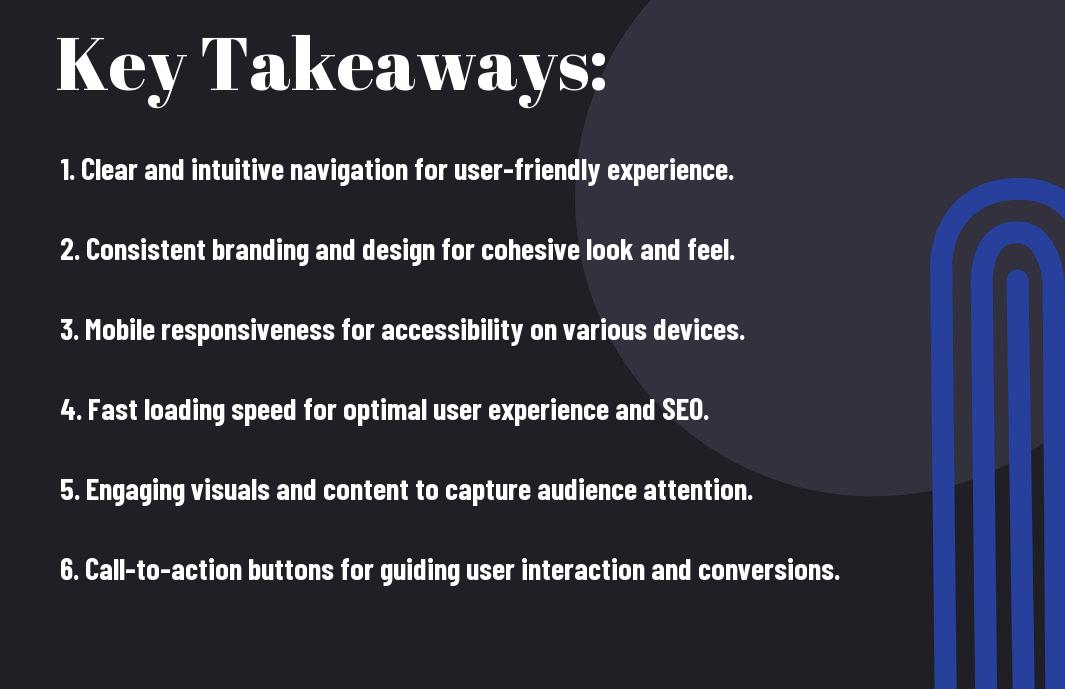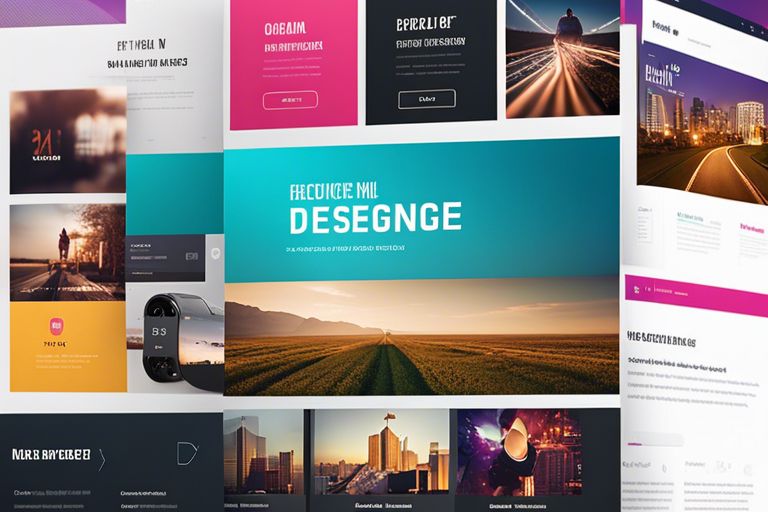When it comes to creating a successful website, there are key elements that can make or break your design. Whether you’re a business owner looking to optimize your online presence or a web designer aiming to enhance your skills, understanding these crucial components is essential. From user experience to visual appeal, your website’s design plays a crucial role in attracting and retaining visitors. In this blog post, we’ll explore the key elements of effective web page design and how you can implement them to create a powerful online presence.
Key Takeaways:
- Clear Navigation: Having a clear and intuitive navigation system is crucial for a user-friendly web page design.
- Consistent Branding: Maintaining consistent branding elements such as logos, colors, and fonts throughout the web page helps to build brand recognition.
- Mobile Responsiveness: With the increasing use of mobile devices, ensuring that the web page is responsive and displays properly on various screen sizes is essential.
- Visual Hierarchy: Establishing a visual hierarchy by using font sizes, colors, and spacing to guide users’ attention to the most important elements on the page is key for effective design.
- Fast Loading Speed: Optimizing the web page to load quickly is crucial for a positive user experience and to improve search engine rankings.

User Experience (UX)
The user experience (UX) is a critical component of effective web page design. It encompasses the overall experience a visitor has when interacting with your website, including factors such as usability, accessibility, and visual appeal. Your goal should be to create a seamless and enjoyable experience for every user who lands on your page.
Navigation and Layout
When it comes to user experience, easy navigation and well-thought-out layout are crucial. You want to make it as simple as possible for users to find what they are looking for on your website. This means using clear, intuitive navigation menus and organizing your content in a logical manner. Your layout should be clean and uncluttered, with a focus on guiding the user through the page without overwhelming them.
Accessibility and Responsiveness
Accessibility and responsiveness are essential aspects of user experience. Your website should be accessible to all users, including those with disabilities. This means using alt text for images, ensuring proper color contrast for readability, and providing keyboard navigation options. Additionally, your site should be responsive, meaning it adapts to different screen sizes and devices for a seamless experience across all platforms.
Loading Speed Optimization
One factor that significantly impacts user experience is loading speed optimization. If your website takes too long to load, you risk losing visitors who are impatient and will move on to another site. You can improve loading speed by optimizing image sizes, minimizing the use of external plugins, and leveraging browser caching. A fast-loading website not only improves user experience but also positively impacts your search engine rankings.
Visual Design
For a successful web page design, visual elements play a crucial role in attracting and engaging your audience. The visual design of your website includes everything from the layout, color scheme, typography, imagery, and iconography. To dive deeper into the key visual design elements, you can also refer to the 20 Key Website Elements for your reference.
Color Theory and Use
When it comes to color theory and use in web design, you must consider the psychology of colors and how they affect emotions and perceptions. The color scheme you choose should reflect your brand identity and resonate with your target audience. You must also ensure that the contrast between background and text is sufficient for clarity and readability.
Typography and Readability
Typography is a critical aspect of web page design as it directly impacts the readability and user experience. Selecting the appropriate font style, size, and spacing is essential to ensure that your content is easy to read on all devices. Remember, the goal is to make it effortless for your visitors to consume your content.
Imagery and Iconography
The use of imagery and iconography on your website contributes to the overall visual appeal and user engagement. High-quality, relevant images and icons can enhance your content and create a connection with your audience. Additionally, consistency in image style across your website helps in establishing a cohesive brand identity.
Content Strategy
Now that you have the basic structure of your web page in place, it’s time to focus on the most crucial aspect of web design: your content strategy. This is the foundation of your website and will greatly impact your user experience and conversions.
Clear Messaging and Calls to Action
When it comes to effective web design, clear messaging and calls to action are absolutely crucial. Your website’s content should effectively communicate your brand’s message and what you have to offer. Make sure your website clearly communicates what you do, the benefits you provide, and why users should choose you over your competitors. Your calls to action should be strong and persuasive, guiding users to take the desired action, whether it’s making a purchase, signing up for a newsletter, or contacting you for more information. Your messaging and calls to action should be clear, concise, and compelling, making it easy for visitors to understand what you want them to do.
Content Hierarchy and Flow
Another important aspect of content strategy is the hierarchy and flow of your content. When a user lands on your website, they should be able to easily navigate through your content, finding exactly what they’re looking for without having to guess where to go next. This means organizing your content in a logical and intuitive manner, with a clear hierarchy that guides users through the most important information first. You want to make sure that your content flow is seamless and intuitive, allowing visitors to effortlessly move through your website and find what they’re looking for without any confusion.
Technical Aspects
Not only should your website be visually appealing and user-friendly, but it should also be technically sound. This means ensuring that your website is well-structured, loads quickly, and is optimized for search engines. To get a comprehensive understanding of the technical aspects of web design, you can refer to the Top 15 Essential Elements of Successful Website Design. This resource will give you valuable insights into the technical elements that contribute to a well-designed website.
SEO Best Practices
When it comes to effective web page design, optimizing your site for search engines is crucial. You want to ensure that your website ranks well on search engine results pages, making it easier for potential visitors to discover your site. You can achieve this by incorporating relevant keywords, creating high-quality content, and obtaining authoritative backlinks. Paying attention to SEO best practices like these will help to improve your website’s visibility and drive organic traffic to your site.
Mobile-First Design Considerations
With the increasing use of mobile devices, it’s essential to consider mobile-first design when creating your website. This means designing and optimizing your site for mobile devices first, and then scaling it up for desktops. Mobile users should have a seamless experience when accessing your site, with easy navigation, fast loading times, and responsive design. By prioritizing mobile-first design, you ensure that your website caters to a large and growing audience of mobile users.

Conclusion: Key Elements of Effective Web Page Design
Following this guide will ensure that you have a clear understanding of the key elements of effective web page design. Incorporating these elements into your website will help you create a visually appealing and user-friendly experience for your visitors. By focusing on aspects such as layout, navigation, content, and mobile responsiveness, you can effectively engage your audience and drive desired actions. Make sure to continually evaluate and update your design to keep up with changing trends and technology, ensuring your website remains a valuable asset to your brand.
Key Elements of Effective Web Page Design – FAQ
Q: What are the key elements of effective web page design?
A: The key elements of effective web page design include clear navigation, responsive design, compelling visual elements, concise and relevant content, and fast loading speeds.
Q: Why is clear navigation important in web page design?
A: Clear navigation is important in web page design because it allows users to easily find the information they are looking for, leading to a better user experience and increase in engagement.
Q: What is responsive design and why is it essential in web page design?
A: Responsive design refers to the ability of a website to adapt to different screen sizes and devices. It is essential in web page design as it ensures that the website looks and functions well on all devices, improving accessibility for users.
Q: How can visual elements contribute to the effectiveness of a web page?
A: Visual elements such as high-quality images, videos, and graphics can enhance the overall appeal of a web page, capture users’ attention, and convey information more effectively than text alone.
Q: Why is fast loading speed crucial in web page design?
A: Fast loading speed is crucial in web page design because it directly impacts user experience and search engine ranking. Slow-loading pages can lead to increased bounce rates and decreased user satisfaction, making it essential for web pages to load quickly.
